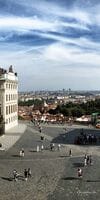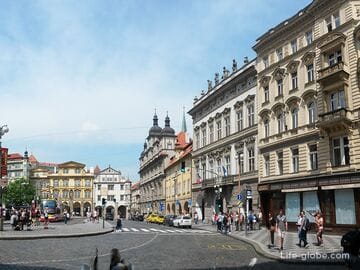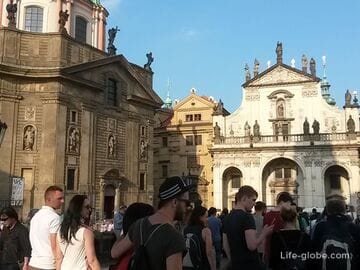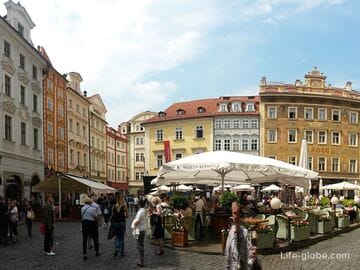Hradčanska Square (Hradčanské náměstí, Hradčanske namesti) is one of the most important and most visited squares in Prague, which is surrounded by historical palaces and on which there is an observation deck.
The square leads to Prague Castle.
Hradcana Square was part of the so - called The Royal Way leading to Prague Castle (Pražský hrad), which is now a tourist route.
Today Hradcana Square is one of the most important and visited squares in Prague. It is located in the historical part of the city and acts as the center of the Hradčany district.
In addition to the very lively tourism, official visits and important events take place on the square. Also, small fairs sometimes work on the square, when they set up tents with street food, souvenirs and other products.
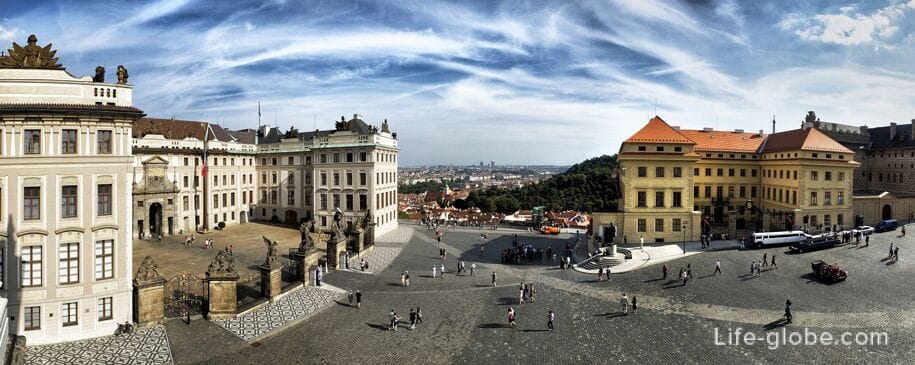
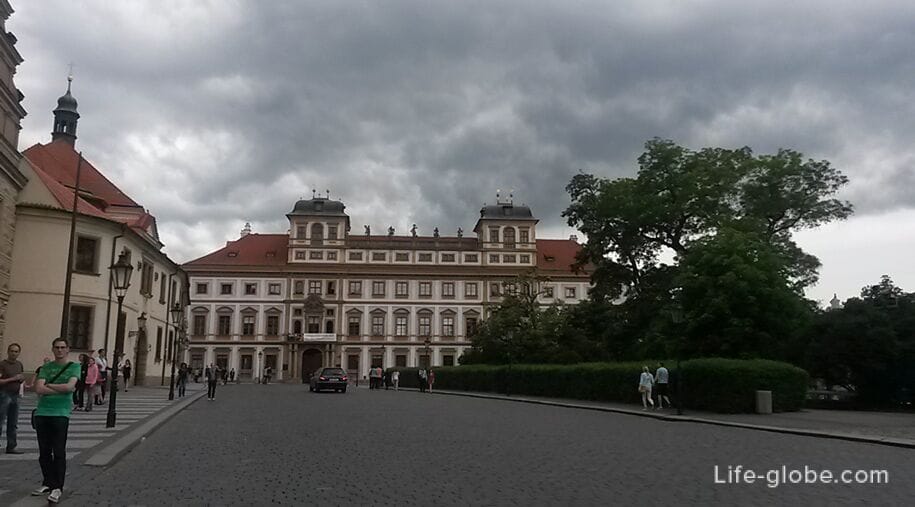
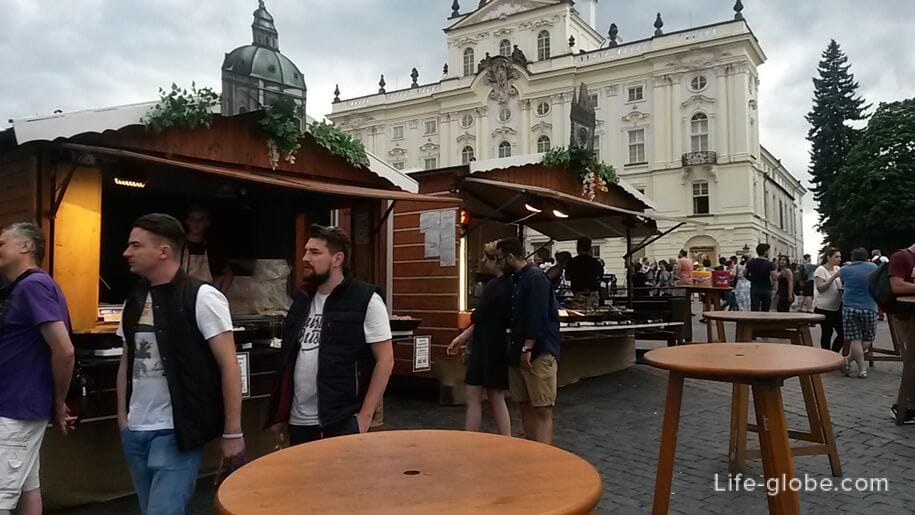

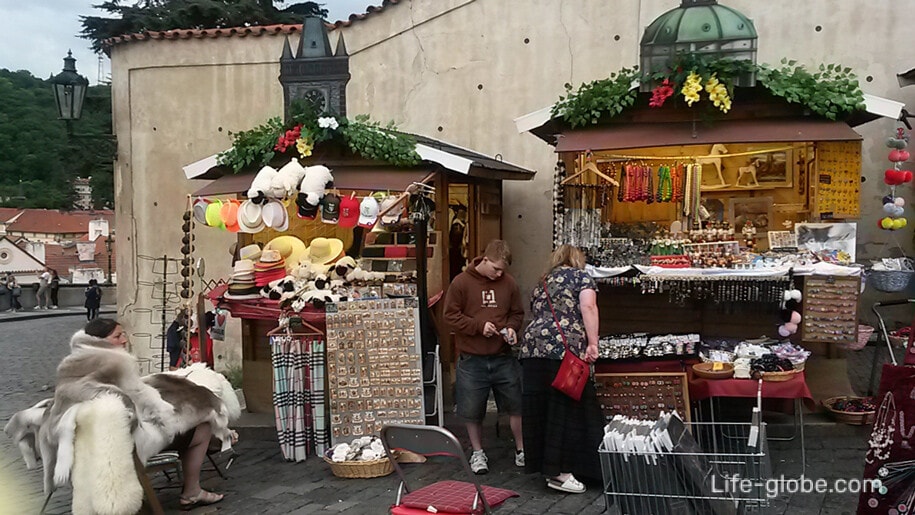
On the south-eastern side of Hradcany Square there is a public observation deck or ramp of the Prague Castle (the street "To the castle", Ke Gradu / ulicí Ke Hradu), from which you can enjoy wonderful panoramic views of Prague.
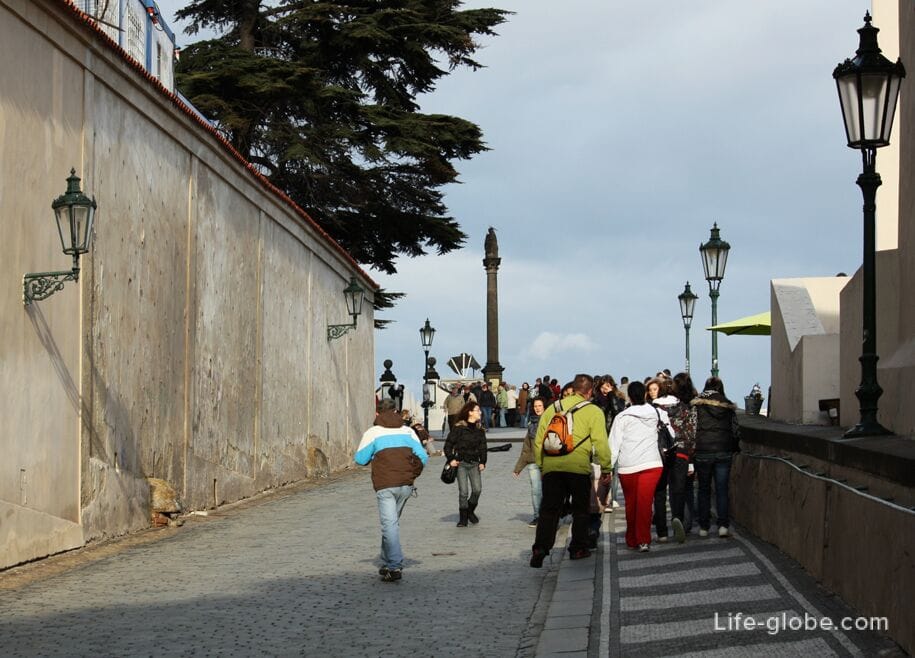
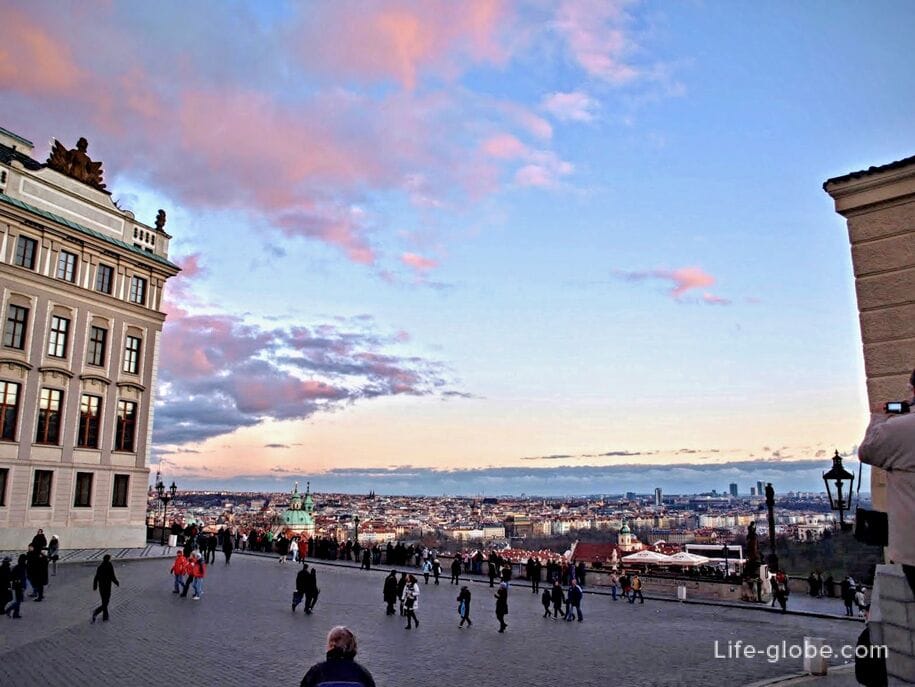
Not far from the ramp of the castle, on Hradcany Square, there is a bronze monument to Thomas Garrigu Masaryk (Památník Tomáše Garrigua Masaryka), opened on March 7, 2000 on the occasion of the 150th anniversary of the birth of Tomáš Garrigu Masaryk, the first president of the Czechoslovak Republic.
The statue of the monument was created based on the original work of the sculptor Otakar Spaniel in 1931, which is located in the Pantheon The National Museum of Prague (Narodni muzeum Praha).
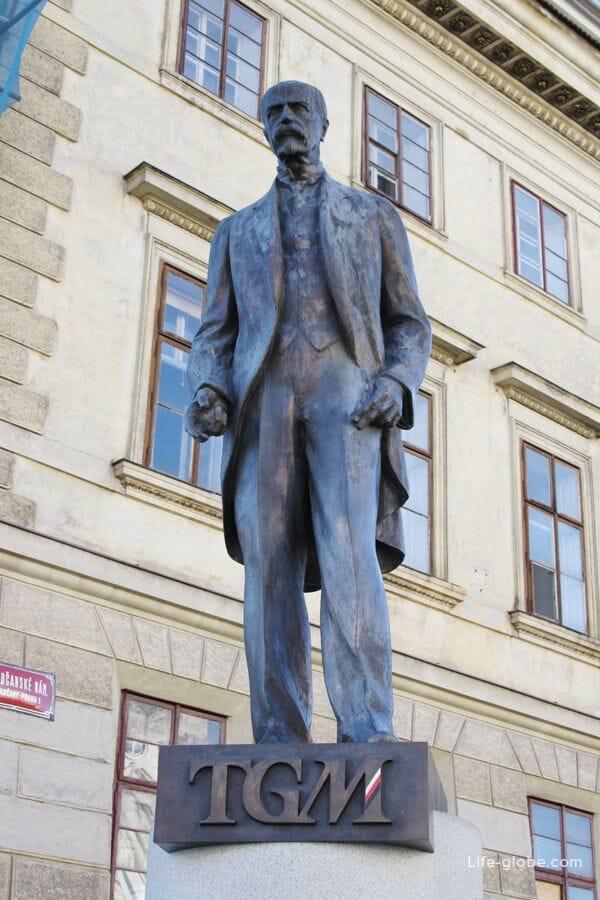
In the central part of Hradcany Square are notable
- green park area with places to relax;
- cast-iron lamppost for street lighting with eight gas lanterns, which was designed by Alexei Linsbauer and sculptor Eduard Vesely, and by 1868 was cast by the Komarno foundry near Beroun. At the bottom of the pillar there are four female figures. The pillar ends with a tall Corinthian column with an allegorical figure symbolizing Prague;
- The Mariana Plague Column (Marianský morový sloup), which is located at the site of the open-air service during the Great Plague of 1713-1714.
The construction of the column was approved by Emperor Charles VI. In 1725, the first stone was laid, but since the city of Hradcany did not have enough funds, the column was not completed and consecrated until 1736. The statue of the Immaculate Conception and the figures of saints on the lattice and on the pillars of the obelisk were created by Ferdinand Maximilian Brokov, and after his death the work was completed by his disciple František Ignac Weiss.
Around the pedestal of the high column are statues of Saints Vitus, Wenceslaus and Adalbert, on the lower pedestal - St. Charles Borromeo, St. John of Nepomuk and St. St. Florian and St. Paul. The statue of the Virgin Mary made of sandstone with a height of 206 centimeters completes the columns. The sculpture was gilded in 1884, and since 1894 it has been replaced by a copy of Ludwik Wurzel. Today, the original statue of the Virgin Mary is kept in the Lapidary of the National Museum of Prague.

Sights (palaces and buildings) around Hradcany Square
A number of historical houses and palaces are concentrated around Hradcany Square.
Prague Castle
The eastern side of Hradcany Square is marked by the front gate leading to the territory of Prague Castle (Pražský hrad), and bearing the name Gate of Giants or gate of Titans (Brána gigantów).
Prague Castle is a majestic symbol and pearl of the Czech Republic, which is one of the largest castle complexes in the world, founded back in the 9th century.
Prague Castle is a complex consisting of four courtyards, the main street, former palaces, auxiliary and residential buildings, a basilica, a picturesque Golden Street and the dominant of Prague Castle - St. Vitus Cathedral with a high tower, in which there is an observation deck. The complex is surrounded by former fortifications - walls with towers and gates, which are adjacent to gardens with some buildings. Learn more about Prague Castle, Titans Gate and Gardens...
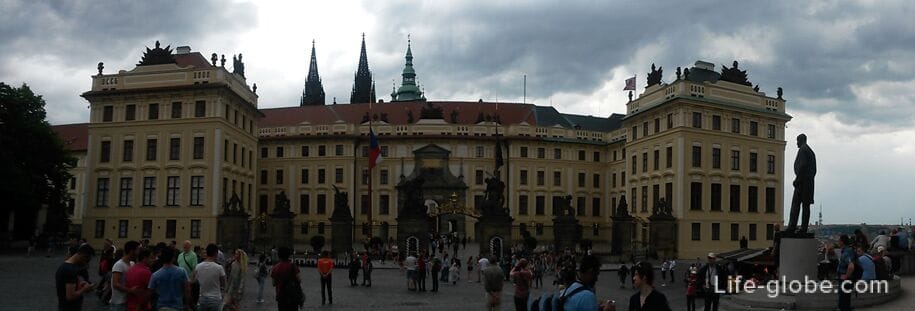
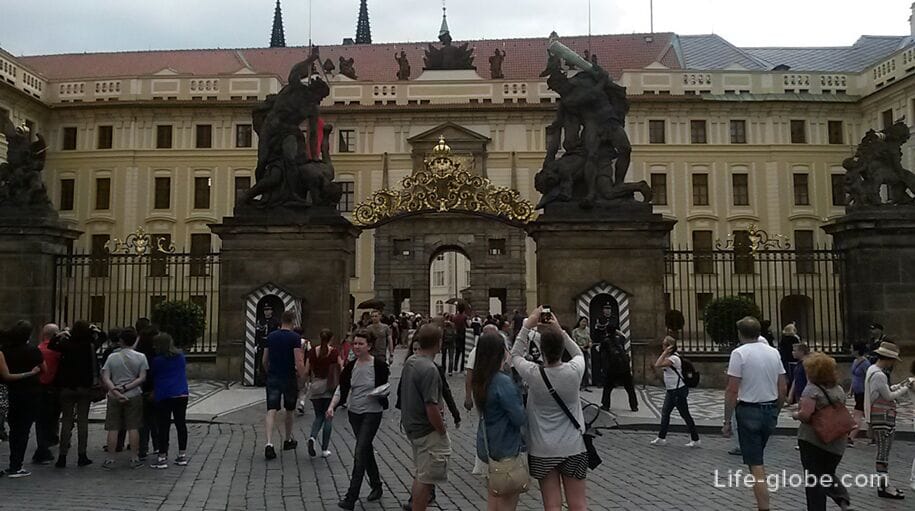
Tuscan Palace
The entire western side of Hradcany Square is occupied by the Tuscan Palace (Toskanský palác).
This early Baroque building was built around 1690 by Count Michael Oswald Thun-Hohenstein, on the site of several residential buildings. In 1718, the unfinished building was bought from the Tuns by Anna Maria Frantiska, Duchess of Tuscany, who later completed the construction (hence the name of the palace "Tuscan").
The palace underwent a complete reconstruction in the 1990s, during which wall frescoes of the 17th century were discovered.
Today, the former palace is used by the Czech Ministry of Foreign Affairs. The public is served by a part of the first floor, where a hall for exhibitions and social events has been created.
Website of the Czech Ministry of Foreign Affairs: mzv.cz/jnp .
Address of the Tuscan Palace: Hradčanské náměstí 5, 118 00 Praha 1 - Hradčany.

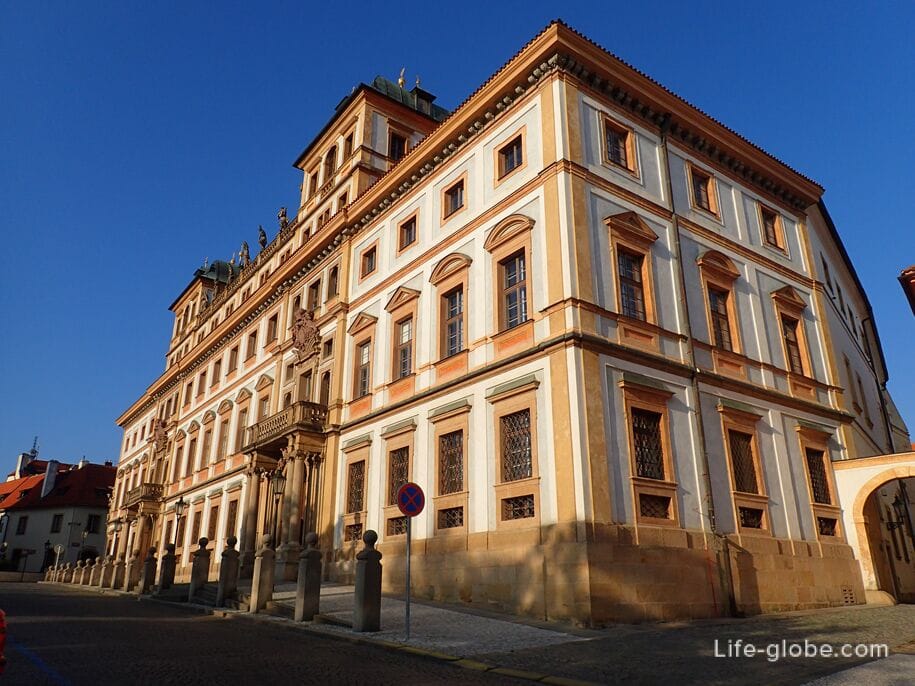
Salmovsky Palace
Salmovsky Palace (Salmovský palác, Salm Palace) is a classic three-winged palace-type building with a court of honor.
The construction of the palace was carried out between 1800 and 1811 by Archbishop of Prague Vilem Florentin, Prince of Salm-Salm, according to the project of František Pavička on the site of several small aristocratic residences. Initially, it was supposed to be a luxurious apartment house, owned since 1811 by the Schwarzenbergs, who connected it with the neighboring Schwarzenberg Palace.
The Salmovsky Palace is made in the style of classicism and, in a French way, has a small courtyard (cour dhonneur), closed from Hradcany Square by a lattice with a gate.
Today, the palace belongs to the National Gallery Prague (Narodní galerie Praha) and is an exhibition space with a long-term exhibition on the ground floor and a series of thematic exhibitions dedicated to international Art Nouveau and contemporary art in the context of works by famous Czech artists.
Website of the National Gallery Prague: ngprague.cz .
Address of the Salmovsky Palace: Hradčanské náměstí 1, 110 00 Praha 1 - Hradčany.

Schwarzenberg Palace (Lobkovitsky Palace)
Schwarzenberg Palace (Schwarzenberský palác) is an original and, moreover, relatively early Renaissance building, the facades of which are decorated with richly shaped graffiti decor.
The palace is an example of the so-called Czech Renaissance with a combination of Italian patterns and Czech traditions.
The palace was built in 1545-1567 by Agostino Galli, nicknamed Vlach, for the Burgrave of Prague, Jan the Younger of Lobkowitz. On behalf of the first owner, the palace is also known as Lobkovichky Palace (Lobkovický palác).
In the past, the palace served as a representative residence of the heads of the Lobkovich, Rosenberg, Eggenberg and finally Schwarzenberg families, who owned the palace until 1947.
Today the palace belongs to the National Gallery Prague. The permanent exhibition in the palace offers a selection of the most important masterpieces from the collection of Old Art. Short-term exhibitions are also held here.
Address of the Schwarzenberg Palace: Hradčanské náměstí 2, 110 00 Praha 1 - Hradčany.
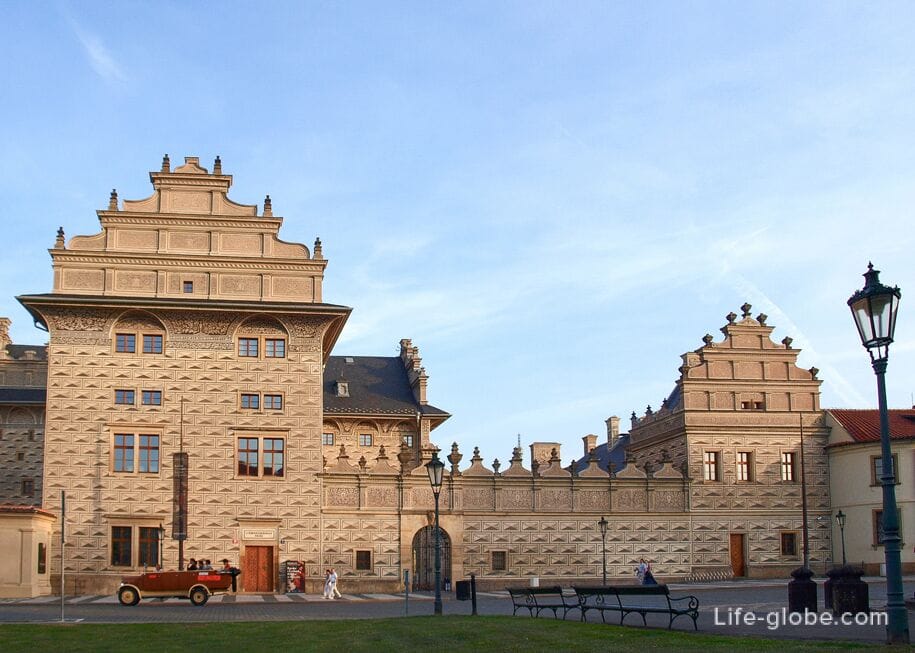
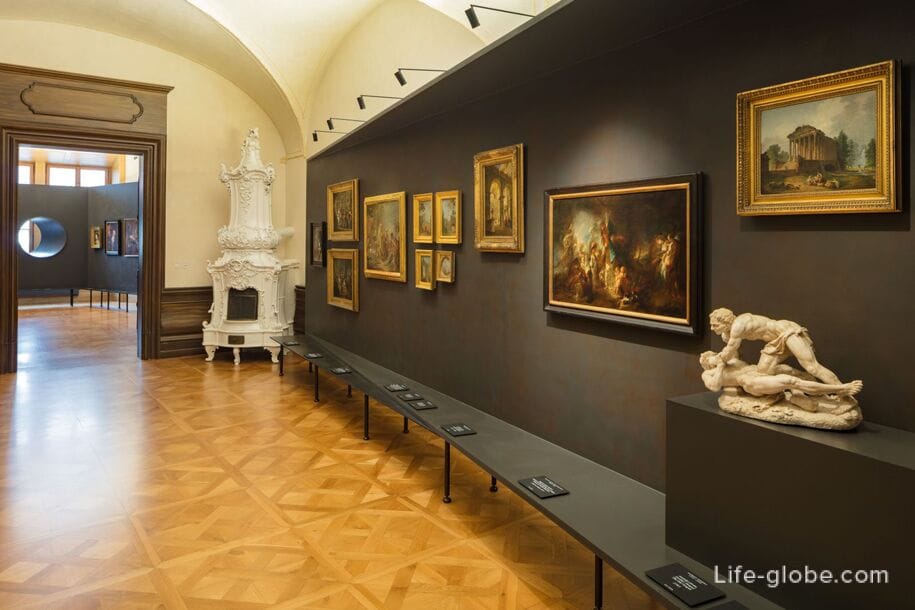
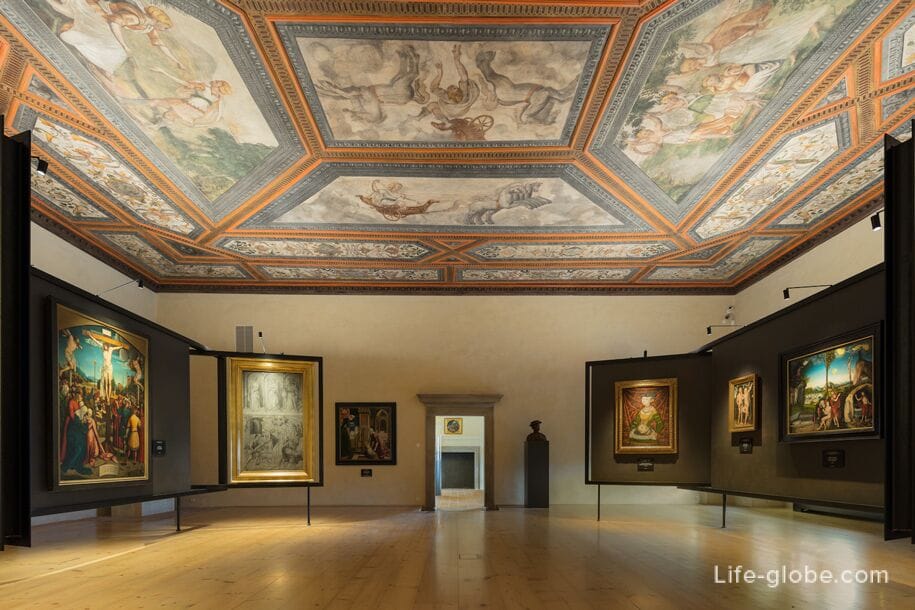
Barefoot Carmelite Monastery with St. Benedict's Church
The Church of St. Benedict (Kostel svatého Benedikta) was originally a parish church of Hradcany, first mentioned in 1353 and dedicated to the Barnabite Order after the Battle of the White Mountain.
Later, the church was rebuilt several times. In 1626, a Barnabite monastery was built next to it, which was dedicated in 1792 as the monastery of the barefoot Carmelites (Klášter bosých karmelitek).
The Church of St. Benedict together with the monastery (Klášter bosých karmelitek) are located on the southwest side of Hradcany Square.
The monastery's website: bosekarmelitky.cz .
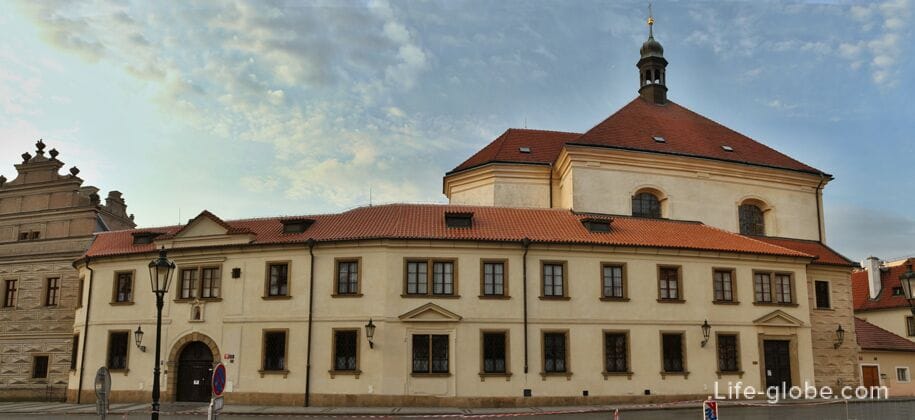
Martin Palace
The Martinick Palace (Martinický palác) is one of the most important Renaissance buildings of the second half of the 16th century in Prague.
After the great fire in Hradcany and Malaya-Strana in 1541, Ondrej Teifl from Kinsdorf and Zeilberg built a residence with a garden, which became the basis of the future palace, on the site of several houses belonging to lower and higher church dignitaries. In 1583, he sold the house to Jiri Borjit from Martinice on Smechka, who began a cardinal reconstruction: enlarged, expanded the building and decorated the facade with a forked pediment.
In the future, alterations of the palace were also carried out.
The exteriors of the palace were richly decorated with figured sgraffito. The facades depict episodes from the life of Joseph of Egypt, the life of Samson and the deeds of Hercules.
Today, the historical interiors of the Martin Palace are rented for conferences, presentations, lectures, exhibitions, gala dinners, fashion shows, wedding ceremonies or concerts.
Various events are also held in the premises of the palace.
Martin Palace website: martinicky-palac.
Address of the Martin Palace: Hradčanské náměstí 8/67, 118 00 Praha 1 - Hradčany.

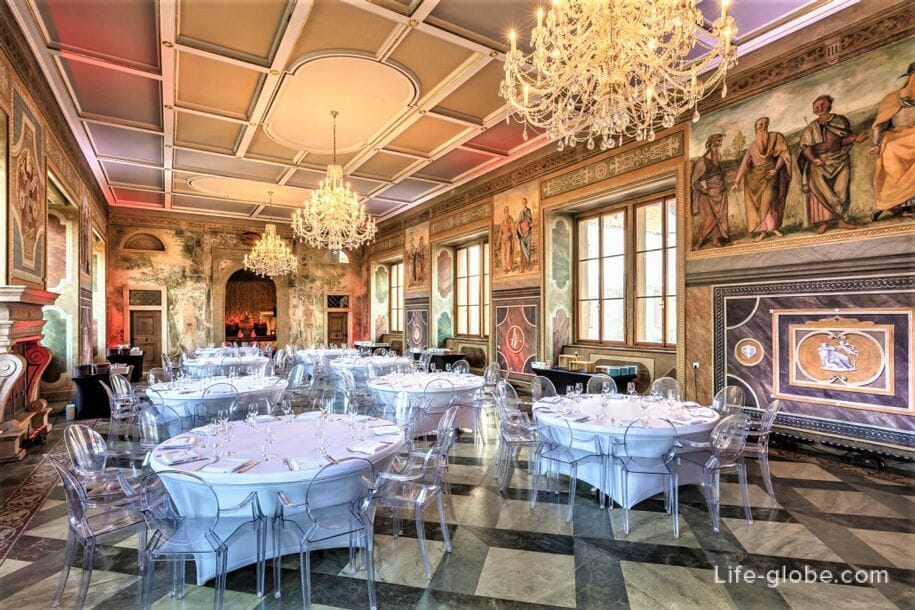
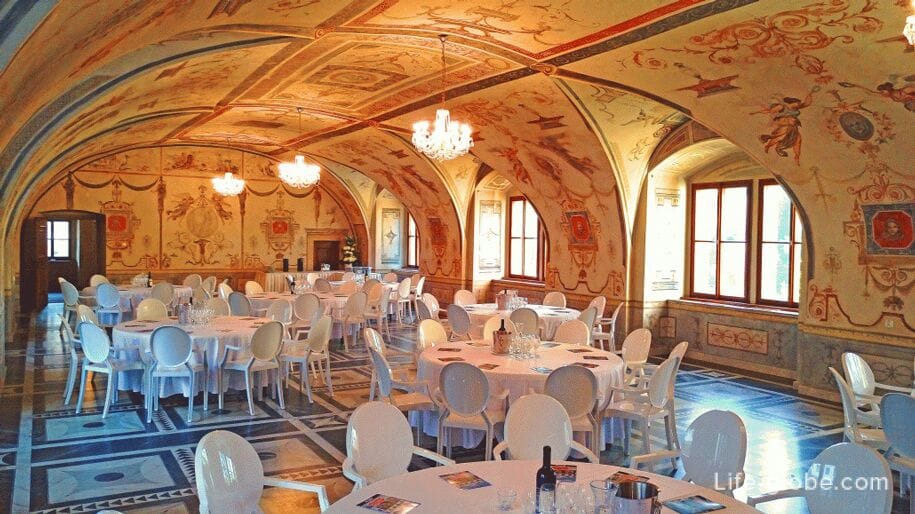
Saxon-Lauenburg Palaces
The name Saxon-Lauenburg Palaces (Sasko-lauenburský palác) is used for a pair of originally Renaissance houses, the unifying element of which is almost identical facades.
These are houses numbered 63/9 (Rozhmberk's house) and 62/10 (archive of the chapter) on Hradchanskaya Square.
Building No. 63/9, sometimes called the Rosenberg House, Kolovrat Palace or the Chapter House (Rožmberský d?m, Kolovratský palác, Kapitulní d?m), belonged to the Rosenbergs in the 14th century, who rebuilt it in Renaissance style after a fire in 1451. At the end of the 16th century, the building was acquired by the Kolovrat family, who created a rich sgraffito decoration preserved in the courtyard.
Building No. 62/10, sometimes called the Saxon-Lauenberg House or the Chapter Archive (Sasko-lauenberský d?m, Kapitulní archiv), is a house in which the builder Peter Parlerzh lived from 1372 until his death in 1399.
Around 1596, both buildings were rebuilt into a three-story Renaissance palace. In 1632, the palace was acquired by Julius Jindrzych from Saxony-Lauenburg, having married Anna Magdalena, born in Lobkovitsy, the widow of Zbinek Novogradsky from Kolovrat. In 1717, the palace was sold to the Prague Metropolitan Chapter, then in 1737 both buildings were rebuilt in the Baroque style by the Prague builder A.V. Spannbrücker and their facades were combined.

Losenovsky Palace
Losenovsky Palace is also known as the House of the Labuti (Losenovský palác, dúm U Labutí) - a small and outwardly inconspicuous palace on the north side of Hradcany Square.
Originally a Renaissance building created by connecting two houses at the end of the 17th century, it was rebuilt in the Baroque style around the middle of the 18th century, and in 1842 it was rebuilt again in the classical style.
Today there is a restaurant on the ground floor of the former palace.
Address of the Losenovsky Palace: Hradčanské náměstí 61/11, 118 00 Praha 1 - Hradčan.
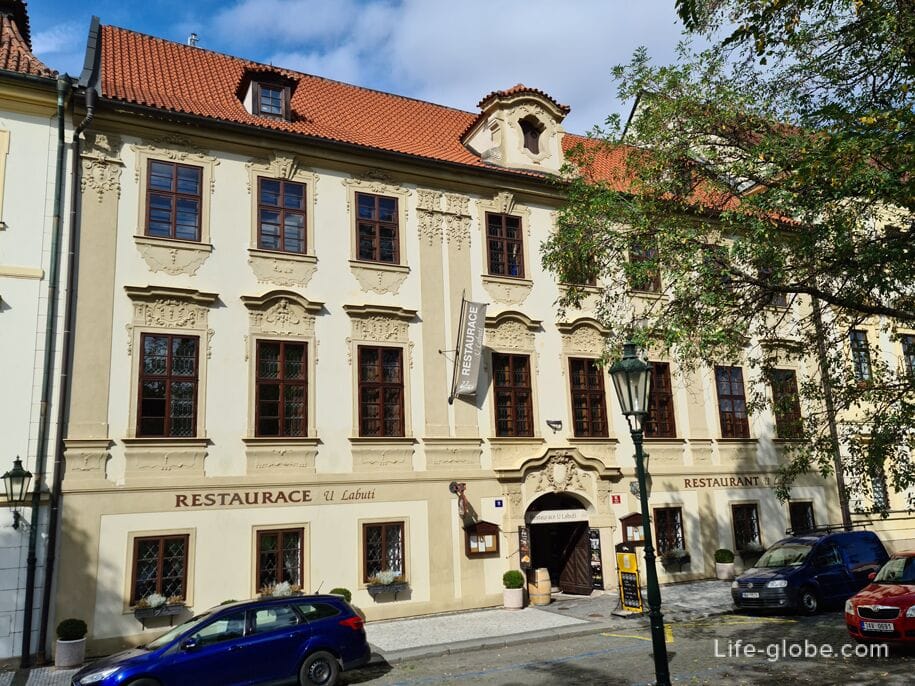
Canonical houses
To the east of the Losenovsky Palace there are small so-called canonical houses - houses in which residential canons, deans, other prelates of the Metropolitan chapter or employees of St. Vitus Cathedral of Prague Castle.
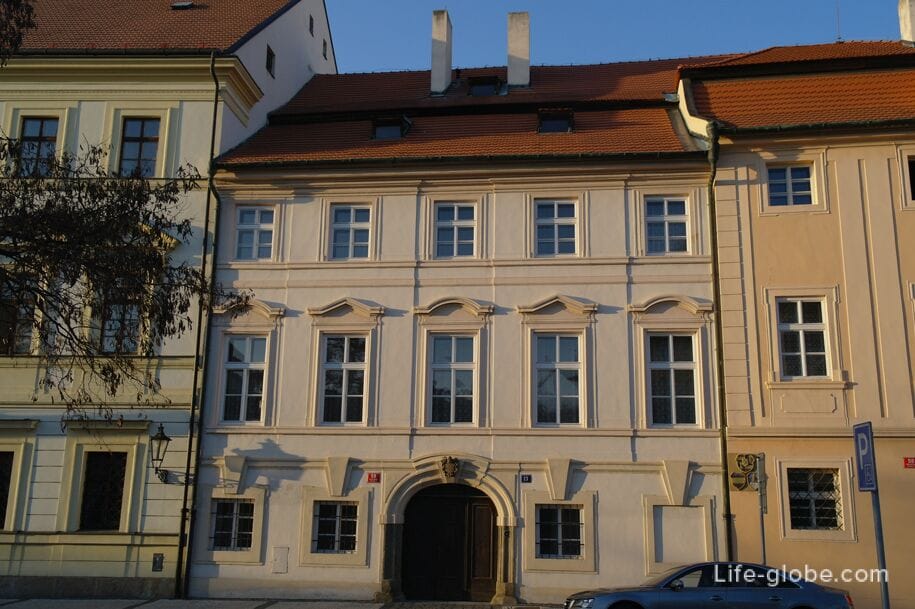
Archbishop 's Palace
The Archiepiscopal Palace (Arcibiskupský palác) is a magnificent historical building in the Baroque and Rococo styles, which is an archiepiscopal consistory.
According to the act of donation dated October 5, 1561, Emperor Ferdinand I donated the house, which stood near Prague Castle and once belonged to Florian Grispach of Grispach, as the residence of the archbishop and his successors. This was the first stage of the construction of the Prague Archdiocese. In the future, the palace was rebuilt and expanded, including absorbing other nearby buildings.
The palace acquired its current appearance in the second half of the 18th century, when it underwent a significant reconstruction in the late Baroque style, the completion of the side wings, the 3rd floor and the decoration of the facade in the Rococo style.
The palace has been the residence of Prague bishops and archbishops since the 1960s.
The main facade of the palace, facing Hradcany Square, has balconies and is decorated with sculptures in the upper part, and also stands out with a powerful portal with a balcony.
The interiors of the palace attract the chapel of St. John the Baptist of the 16th century with frescoes and stucco, halls with tapestries and paintings, as well as a staircase with statues.
The address of the Archbishop's Palace: Hradčanské náměstí 56/16, 119 02 Praha 1 - Hradčany. More about the Archbishop's Palace...
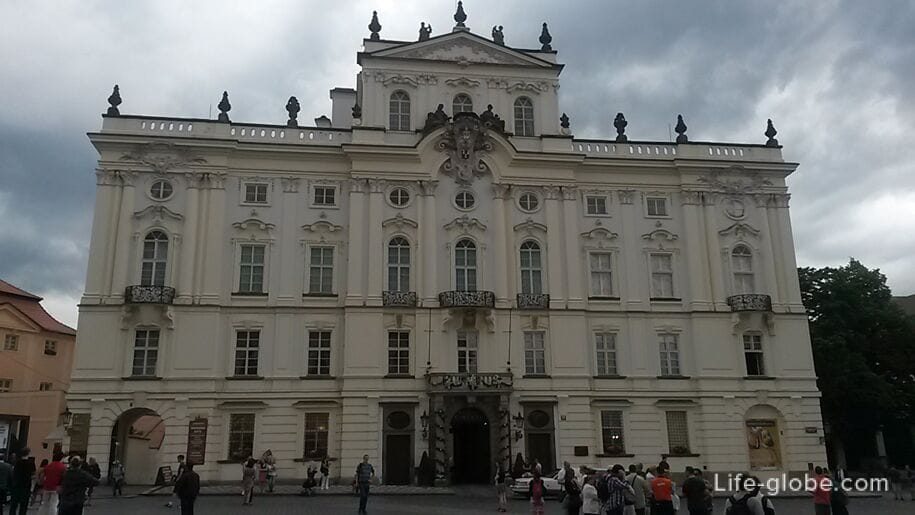

Sternberg Palace
On the west side of the Archbishop's Palace there is a narrow road that leads down to the Sternberg Palace or the Sternberg Palace (Šternberský palác), which is one of the most significant works of secular architecture of the emerging high Baroque in the Czech Republic.
It was a city palace with a garden, built in 1699-1708 for Count Vaclav Vojtech from Sternberk, who, as a descendant of one of the oldest aristocratic families, belonged to the most powerful Czech aristocrats. The palace was owned by the family as a fideikomis until 1811, it housed the Society of Patriotic Friends of Art. After 1871, for several years the palace served as a place for the mentally ill.
Today, the former palace belongs to the National Gallery Prague with a permanent exhibition. Temporary exhibitions are also held here.
The halls of the palace also attract attention with the interior, in which the original decor is fragmentary: stucco, paintings, gold embossing and Chinese motifs.
A beautiful palace garden adjoins the palace. In the garden there are works of art of Czech sculpture of the 20th century, including sculptures by Jan Stursa, Vincenz Makovsky, Brzetislav Benda or Josef Kaplitsky.
Address of the Sternberg Palace: Hradčanské náměstí 15, 110 00 Praha 1 - Hradčany. More about the Sternberg Palace...

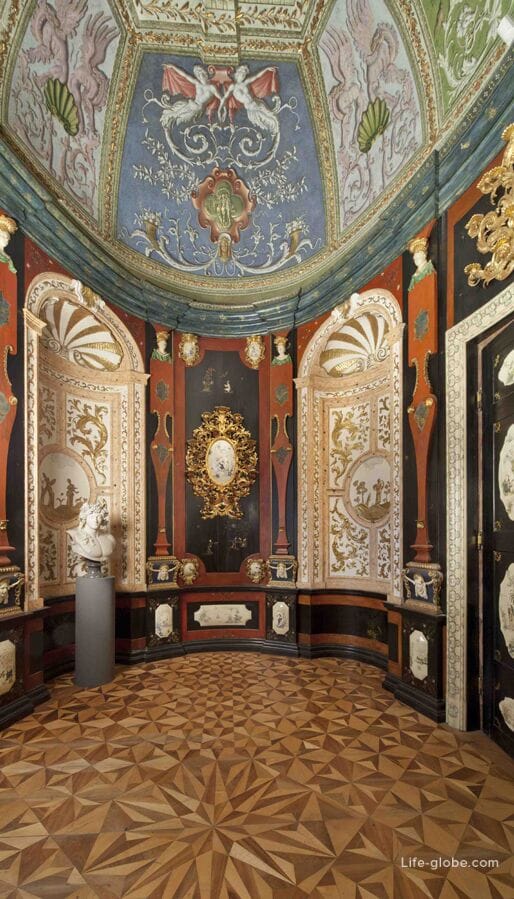
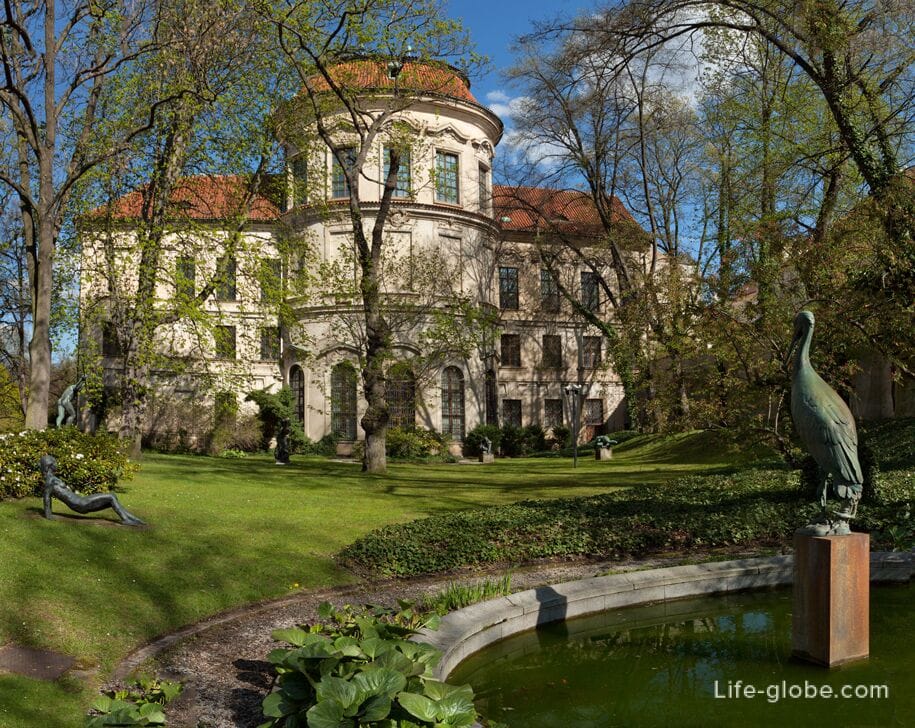
Coordinates of Hradcany Square: 50°05'22.9"N 14°23'51.0"E (50.089700, 14.397500).
All accommodation facilities in Prague (hotels, apartments, guest houses, etc.), including near Hradcany Square, in the historical center of the city and more remotely from those, can be viewed and booked here




